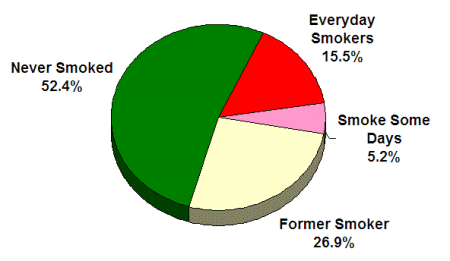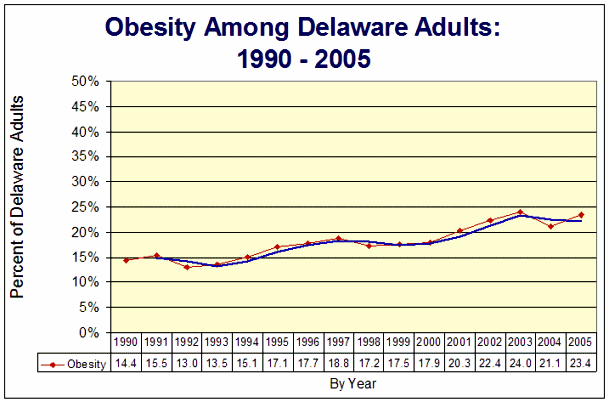Current Suspected Overdose Deaths in Delaware for 2025: Get Help Now!
Find school water testing results and additional resources
Attention Medicaid Participants: Eligibility Renewals Restarted April 1, 2023
Smoking prevalence decreased to 20.7% among Delaware adults in 2005. This is the lowest smoking prevalence in Delaware since the Behavioral Risk Factor Surveillance System began in 1982. For detailed smoking data, go to our fact sheet on adult smoking in Delaware.

Nearly 14% of adult Delawareans get no physical activity in an average week, and another 41% get some activity, but not enough to meet recommendations for either moderate of vigorous physical activity.
Risk from not being active increases steadily with age, from 7.4% of 18-24 year-olds reporting no activity to 23.4% among adults age 65 and older.
No physical activity (by race or ethnicity):
Adults with less than a high school education are more likely to be completely sedentary (29.6%) than high school graduates (16.8%) or college graduates (8.6%).
More than half (54.8%) of all adults are physically inactive—that is, they do not meet minimum recommendations for even moderate physical activity or they get no activity at all.
About 45.1% of Delaware adults meet recommendations for regular, moderate or vigorous physical activity:
The Behavioral Risk Factor Survey measures fruit and vegetable intake as an indicator of a healthy diet. Dietary guidelines from the U.S. Department of Health and Human Services and from the National Academy of Sciences recommend between 5 and 10 servings of a variety of vegetables and fruits every day.
Only 21.3% of Delaware adults eat the recommended 5 or more servings of vegetables and fruits daily.
Percentage of adults 18 and older who eat 5 or more servings a day:
College graduates (27%) and older adults (27%) are more likely to eat 5 or more servings a day.
About 63% of all adult Delawareans are estimated as either "overweight" or "obese."
This is a conservative estimate, given that validity studies indicate a tendency by respondents to overestimate height and underestimate weight. The BRFS asks height and weight, and uses Body Mass Index (BMI) to calculate overweight (BMI 25-29.9) and obesity (BMI = > 30).
39.4% of adults are overweight, and another 23.5% are obese.
Obesity by gender:
Obesity increases by age (the decline among older adults is likely attributable to death from obesity-related diseases including diabetes, heart disease and cancer):
Obesity by racial/ethnic group:
College graduates are significantly less likely to be obese (18.5%) than high school graduates (26.8%) and adults with less than a high-school education (32.2%).
The graph below shows a trend of increasing obesity among Delaware adults in the past decade, leveling off slightly in 2004-05.

Source: Delaware Health and Social Services, Division of Public Health, Behavioral Risk Factor Surveillance System (BRFSS), 2005. The trend line is blue.
About half (50.4%) of Delaware adults responded that they are currently trying to lose weight. Women (57.7%) are more likely than men (42.5%) to say they are trying to lose weight. There is no significant difference between whites and African Americans on this question.
Of respondents who are trying to lose weight, 21.6% say they are eating fewer calories, 13.3% say they are reducing fat in their diet, and 48% say they are trying to reduce both calories and fat intake. About 71% say they are trying to use physical activity or exercise to lose weight.
Only 16% of adults say they have received advice in the past year from a doctor, nurse or other health professional to lose weight. Slightly over 1% of adults say they have been advised by a doctor to gain weight.
Direct medical expenditures in Delaware attributable to obesity are estimated at more than $207 million a year. [Finkelstein et al, “State-Level Estimates of Annual Medical Expenditures Attributable to Obesity,” Obesity Research, 12:1, Jan 2004.]
About 8.5% of Delaware adults say they have been told by a doctor that they have diabetes. Obesity is a major risk factor for diabetes, and the trends show both obesity and diabetes increasing in Delaware during the past decade. The prevalence of diabetes among adults in the state increased from 4.3% in1995 to 8.5% in 2005.
For more detailed BRFS data on diabetes, go to our diabetes data page.
15.6% of Delaware adults report episodes of acute heavy drinking, usually called "binge drinking ," during the past month.
Males, and especially young adult males, report the highest levels of binge drinking.
Binge drinking by gender and age:
"Binge drinking" by racial/ethnic group:
56.7% of adult Delawareans say they have consumed alcoholic beverages in the past month.
5.4% of adult Delawareans are at risk due to heavy drinking. Breakdowns for heavy drinking:
About 28.2% of Delaware adults said they had an influenza , or "flu," shot during the past year.
Women are slightly more likely to have a flu shot than men, with 30.2% of women and 26.1% of men reporting the shot in the past 12 months.
By race:
Influenza shots are recommended for adults with chronic diseases and adults 50 and older (especially those 65 and older), as well as for young children. Appropriately, the prevalence of flu immunization is higher among older adults: 65.8% of adults age 65 and older had a flu shot in the past year.
Health officials also recommend pneumonia vaccine for older adults and individuals of all ages with chronic diseases. Pneumonia vaccine does not need to given annually; you should check with your physician or health care provider to see if you need it.
Among Delaware adults under 65 years of age, 47.4% say they have been tested for the Human Immunodeficiency Virus (HIV) that causes AIDS. 43.9% of men and 50.7% of women say they have been tested at least once.
64.2% of adults in the 25-34 year age group say they have been tested at some time for AIDS, but only 48.4% of younger adults in the 18-24 age group have ever had an AIDS test.
Adults under 65 who have ever had an AIDS test, by race:
Education and income level do not seem to influence whether an individual has had an AIDS test.
To encourage honest responses and anonymity, the BRFS asks a general question about the major risk behaviors related to HIV transmission. The question is: "I'm going to read a list. When I'm done, please tell me if any of the situations apply to you. You don't need to tell me which one. You have used intravenous drugs in the past year. You have been treated for a sexually transmitted or venereal disease in the past year. You have given or received money or drugs in exchange for sex in the past year. You had anal sex without a condom in the past year."
Risky behavior by age group:
Risky behavior by gender:
Risky behavior by race:
Delaware adults with less than a high school education (9.7%) are more likely to engage in risky sexual and drug-related behaviors.
The BRFS estimates that 8.5% of Delaware adults (about 53,700 people) currently have asthma.
For more information on asthma in Delaware, see the Burden of Asthma in Delaware report, published in 2005.
Some asthma breakdowns for 2005:
About 32% of adults with current asthma said they had one or more doctor visits during the past year "for urgent treatment of worsening asthma symptoms."
19% of adults with current asthma reported one or more visits to an emergency room or urgent care center because of asthma.
20.4% of adults with current asthma reported being "unable to work or carry out usual activities" one or more days during the past month because of asthma.
35% of adults with current asthma take prescription medicine daily to prevent an asthma attack from occurring, and another 21.2% say they use their prescription medication from 1 to 24 days of each month.
Almost all adults with current asthma report using a prescription inhaler to stop an asthma attack. 14.3% say they use their inhalers frequently (30-100 times per month); but the majority (72.7%) say they use inhalers to stop asthma attacks only 1 to 14 times a month — indicating better control of their asthma.
The Behavioral Risk Factor Survey also asks questions about tests for heart disease and cancer:
| Risk Factors | New Castle | Kent | Sussex |
|---|---|---|---|
| Adults Getting Regular Moderate or Vigorous Activity | 45% | 42.9% | 47.8% |
| Adult Obesity (BMI 30 or higher) | 21.6% | 26.8% | 26.9% |
| Overweight (BMI 25-29.9) | 39.9% | 37.1% | 39.8% |
| Eat 5 Fruits/Veggies a Day | 21.2% | 20.3% | 22.1% |
| Adults With Diabetes | 7.9% | 9.9% | 9.4% |
| Currently Have Asthma | 8.2% | 8.4% | 9.5% |
| Currently Smoke Cigarettes | 19.3% | 23.9% | 22.8% |
| Acute "Binge" Drinkers >5 drinks per occasion | 16.3% | 14.5% | 14.6% |
| Chronic Heavy Drinkers | 5.9% | 4% | 5.3% |
Source: Delaware Health and Social Services, Division of Public Health, Behavioral Risk Factor Surveillance System (BRFSS), 2005.
Sample = 4,148 Delaware adults age 18 and older. Confidence interval on questions involving total sample is approximately ± 2% at a 95% confidence level. Where the sample size is small, for example for the Hispanic population, the confidence interval is larger and is therefore shown in parenthesis. The Behavioral Risk Factor Survey is a random sample telephone interview survey, conducted continuously throughout the year. Additional information is available on this website or the BRFSS website at the Centers for Disease Control and Prevention.